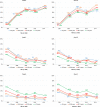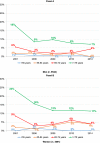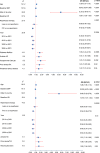Contemporary Trends and Age-Specific Sex Differences in Management and Outcome for Patients With ST-Segment Elevation Myocardial Infarction
- PMID: 27881426
- PMCID: PMC5210417
- DOI: 10.1161/JAHA.116.004202
Contemporary Trends and Age-Specific Sex Differences in Management and Outcome for Patients With ST-Segment Elevation Myocardial Infarction
Abstract
Background: Age- and sex-specific differences exist in the treatment and outcome of ST-elevation myocardial infarction (STEMI). We sought to describe age- and sex-matched contemporary trends of in-hospital management and outcome of patients with STEMI.
Methods and results: We analyzed data from 5 Italian nationwide prospective registries, conducted between 2001 and 2014, including consecutive patients with STEMI. All the analyses were age- and sex-matched, considering 4 age classes: <55, 55 to 64, 65 to 74, and ≥75 years. A total of 13 235 patients were classified as having STEMI (72.1% men and 27.9% women). A progressive shift from thrombolysis to primary percutaneous coronary intervention occurred over time, with a concomitant increase in overall reperfusion rates (P for trend <0.0001), which was consistent across sex and age classes. The crude rates of in-hospital death were 3.2% in men and 8.4% in women (P<0.0001), with a significant increase over age classes for both sexes and a significant decrease over time for both sexes (all P for trend <0.01). On multivariable analysis, age (odds ratio 1.09, 95% CI 1.07-1.10, P<0.0001) and female sex (odds ratio 1.44, 95% CI 1.07-1.93, P=0.009) were found to be significantly associated with in-hospital mortality after adjustment for other risk factors, but no significant interaction between these 2 variables was observed (P for interaction=0.61).
Conclusions: Despite a nationwide shift from thrombolytic therapy to primary percutaneous coronary intervention for STEMI affecting both sexes and all ages, women continue to experience higher in-hospital mortality than men, irrespective of age.
Keywords: ST‐segment elevation myocardial infarction; percutaneous coronary intervention; registry; sex.
© 2016 The Authors. Published on behalf of the American Heart Association, Inc., by Wiley Blackwell.
Figures





References
-
- Mozaffarian D, Benjamin EJ, Go AS, Arnett DK, Blaha MJ, Cushman M, Das SR, de Ferranti S, Després JP, Fullerton HJ, Howard VJ, Huffman MD, Isasi CR, Jiménez MC, Judd SE, Kissela BM, Lichtman JH, Lisabeth LD, Liu S, Mackey RH, Magid DJ, McGuire DK, Mohler ER III, Moy CS, Muntner P, Mussolino ME, Nasir K, Neumar RW, Nichol G, Palaniappan L, Pandey DK, Reeves MJ, Rodriguez CJ, Rosamond W, Sorlie PD, Stein J, Towfighi A, Turan TN, Virani SS, Woo D, Yeh RW, Turner MB; American Heart Association Statistics Committee; Stroke Statistics Subcommittee . Heart disease and stroke statistics—2016 update: a report from the American Heart Association. Circulation. 2016;133:e38–e360. - PubMed
-
- Mehta LS, Beckie TM, DeVon HA, Grines CL, Krumholz HM, Johnson MN, Lindley KJ, Vaccarino V, Wang TY, Watson KE, Wenger NK; American Heart Association Cardiovascular Disease in Women and Special Populations Committee of the Council on Clinical Cardiology, Council on Epidemiology and Prevention, Council on Cardiovascular and Stroke Nursing, and Council on Quality of Care and Outcomes Research . Acute myocardial infarction in women: a scientific statement from the American Heart Association. Circulation. 2016;133:916–947. - PubMed
-
- Pancholy SB, Shantha GP, Patel T, Cheskin LJ. Sex differences in short term and long‐term all‐cause mortality among patients with ST‐segment elevation myocardial infarction treated by primary percutaneous intervention: a meta‐analysis. JAMA Intern Med. 2014;174:1822–1830. - PubMed
-
- Stone GW, Grines CL, Browne KF, Marco J, Rothbaum D, O'Keefe J, Hartzler GO, Overlie P, Donohue B, Chelliah N. Comparison of in‐hospital outcome in men versus women treated by either thrombolytic therapy or primary coronary angioplasty for acute myocardial infarction. Am J Cardiol. 1995;75:987–992. - PubMed
-
- Di Chiara A, Chiarella F, Savonitto S, Lucci D, Bolognese L, De Servi S, Greco C, Boccanelli A, Zonzin P, Coccolini S, Maggioni AP; BLITZ Investigators . Epidemiology of acute myocardial infarction in the Italian CCU network: the BLITZ study. Eur Heart J. 2003;24:1616–1629. - PubMed
Publication types
MeSH terms
LinkOut - more resources
Full Text Sources
Other Literature Sources

